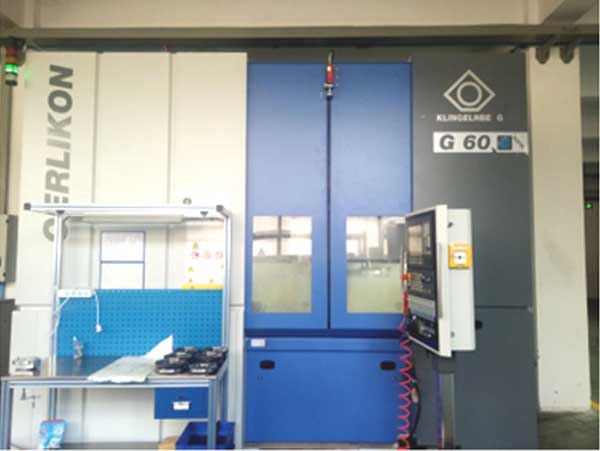Epicycloidal bevel gears are critical components for transmitting motion and power between intersecting or offset axes in automotive, aerospace, and industrial machinery. Unlike circular-arc bevel gears requiring five-cut methods with indexing interruptions, epicycloidal variants enable continuous indexing during gear milling. This efficiency and superior meshing smoothness make them increasingly preferred for noise-sensitive applications, though their complex kinematics have hindered domestic manufacturing capabilities in some regions. This research establishes a comprehensive motion control framework for epicycloidal bevel gear milling through kinematic derivations and virtual verification, addressing a fundamental gap in continuous indexing gear milling technology.
Kinematic Analysis of Epicycloidal Bevel Gear Milling Machines
The cutting process simulates meshing between a generating gear and workpiece. Multi-blade cutter heads with inner (I) and outer (A) blades simultaneously mill convex and concave tooth surfaces. Crucially, each cutter blade group advances the workpiece by one tooth per pass through coordinated motions governed by:
$$ \omega_B = \frac{z_p}{z} \omega_H + \frac{z_O}{z} \omega_H – \frac{z_O}{z} \omega’_O $$
where $\omega_B$ = workpiece angular velocity, $\omega_H$ = cradle angular velocity, $\omega’_O$ = cutter absolute velocity, $z_p$ = generating gear teeth, $z_O$ = cutter blade groups, $z$ = workpiece teeth. For mechanical gear milling machines (e.g., AMK852), transmission chains introduce cradle-induced cutter motion:
$$ \omega’_O = \omega_H \left(1 + \frac{1}{28}\right) + \omega_O $$
Substituting yields the consolidated motion equation:
$$ \omega_B = \left( \frac{z_p}{z} – \frac{z_O}{28z} \right) \omega_H – \frac{z_O}{z} \omega_O $$
For CNC gear milling machines without mechanical linkages, $\omega’_O = \omega_O$, simplifying to:
$$ \omega_B = \omega_H \left( \frac{z_p}{z} + \frac{z_O}{z} \right) – \frac{z_O}{z} \omega_O $$
Both forms decompose $\omega_B$ into cradle-dependent ($\omega_{B1}$) and cutter-dependent ($\omega_{B2}$) components:
$$ \omega_{B1} = k_1 \omega_H, \quad \omega_{B2} = -k_2 \omega_O $$
$$ \text{where } k_1 = \frac{z_p}{z} \pm \frac{z_O}{28z}, \quad k_2 = \frac{z_O}{z} $$
Table 1 compares kinematic parameters for mechanical vs CNC implementations:
| Parameter | Mechanical Gear Milling | CNC Gear Milling |
|---|---|---|
| Cutter velocity ($\omega’_O$) | $\omega_H (1 + i_{HO1}) + \omega_O$ | $\omega_O$ |
| Workpiece velocity ($\omega_B$) | $\left( \frac{z_p}{z} – \frac{z_O}{28z} \right) \omega_H – \frac{z_O}{z} \omega_O$ | $\omega_H \left( \frac{z_p}{z} + \frac{z_O}{z} \right) – \frac{z_O}{z} \omega_O$ |
| Synchronization method | Differential mechanism | Electronic gearing |
CNC Motion Implementation Strategy
CNC gear milling machines replace mechanical transmissions with independent servo axes. Implementing Equation 4 requires:
- Virtual Axis Decomposition: $\omega_B$ is split into virtual axes $A_1$ (cradle-linked) and $A_2$ (cutter-linked):
$$ A_1: \theta_1(t) = \int_0^t k_1 \omega_H(\tau) d\tau, \quad A_2: \theta_2(t) = -\int_0^t k_2 \omega_O(\tau) d\tau $$ - Motion Control:
- $A_1$: Synchronized with cradle-mimicking axes (X,Y) via linear/spline interpolation
- $A_2$: Electronically geared to cutter spindle (C) using encoder feedback. If $N_C$ pulses from cutter encoder, $A_2$ command pulses are:
$$ N_{A2} = -k_2 N_C $$
- Axis Synthesis: Total workpiece command:
$$ \theta_B = \theta_1 + \theta_2 $$
This enables continuous indexing during gear milling without mechanical differentials. Figure 1 illustrates a typical CNC architecture:

Machining Simulation Platform
VERICUT™ simulates the derived kinematics using:
- Machine Model:
$$ \begin{bmatrix} X \\ Y \\ Z \\ B \\ C \\ A \end{bmatrix} \rightarrow \text{Transformation chains} $$ - Tool Simplification: Blade groups represented as conical mills (Table 2):
Blade Type Virtual Tool Pressure Angle Function Outer (A) Conical mill 20°03′ Concave surface Inner (I) Conical mill 20°03′ Convex surface Roughing Conical mill 18° Stock removal - Workpiece: Parametric blank model positioned via:
$$ \text{Installation offset} = [\Delta X, \Delta Y, \Delta Z, \theta_B] $$
Simulation Experiment
A 9×40 hypoid gear set was simulated using parameters:
| Gear Parameters | Milling Setup | ||
|---|---|---|---|
| Pinion teeth | 9 | Cradle radius | 245.4 mm |
| Gear teeth | 40 | Blade groups | 17 |
| Pressure angle | 22° | Roll ratio | 4.5556 |
Motion control followed Equation 4 with CNC simplification. Erroneous velocity synthesis ($\omega_B = \frac{z_O}{z} \omega_O + \frac{z_p}{z} \omega_H$) caused tooth indexing errors (Figure 2a). Correct implementation yielded accurate tooth geometry (Figure 2b), validating:
$$ \Delta \theta_{\text{error}} = \int \left[ \left(\frac{z_p}{z} \omega_H – \frac{z_O}{z} \omega_O\right) – \left(\frac{z_p}{z} \omega_H + \frac{z_O}{z} \omega_H – \frac{z_O}{z} \omega_O\right) \right] dt = \frac{z_O}{z} \int \omega_H dt $$
Conclusion
This research establishes a foundational kinematic model for epicycloidal bevel gear milling, demonstrating that cradle motion induces cutter velocity components requiring integration into workpiece control equations. The VERICUT simulation platform verifies that successful gear milling demands synchronized motion per Equation 4. This framework enables accurate CNC algorithm development, advancing domestic production capabilities for high-efficiency epicycloidal gear milling. Future work will optimize dry gear milling parameters using this virtual environment.
